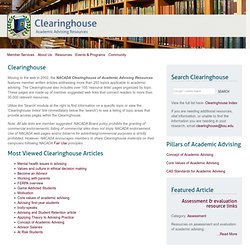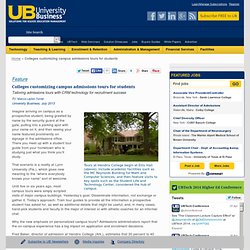Academic Advising
> Annahemming
Who-advises-best-pros-or-profs. Photo Academic advising has always been one of those intractable problems on college campuses.

Students rarely think about it until that frantic moment when they need someone to sign the registration form for next semester’s classes. Only 4 of 10 students consider counselors their primary source of advice regarding academic plans, according to the National Survey of Student Engagement, an annual poll of freshmen and seniors. A third of freshmen turn to friends or family. One in 10 students never even meet with an academic counselor. While students may treat advising as an afterthought, the cost of acting on bad advice can be considerable. Professors have long shrugged off such circuitous routes to a degree as once-in-a-lifetime opportunities for students to explore a wide array of academic disciplines. “When it comes to helping students be engaged, to give them advice about what they need to do outside the classroom, faculty are not always the best,” said Charlie L.
Ms. To Dr.
Technology used for intrusive advising. Emerging Issues in Academic Advising Theory. Emerging Issues Notes. TechKNOW Tools. #DigitalAdvising @YourSchool!
NACADA > Resources > Clearinghouse. Moving to the web in 2002, the NACADA Clearinghouse of Academic Advising Resources features member written articles addressing more than 250 topics applicable to academic advising.

The Clearinghouse also includes over 100 'resource links' pages organized by topic. These pages are made up of member suggested web links that connect readers to more than 30,000 relevant resources. Utilize the 'Search' module at the right to find information on a specific topic or view the 'Clearinghouse Index' link (immediately below the 'search') to see a listing of topic areas that provide access pages within the Clearinghouse.
Note: All site links are member suggested. NACADA Board policy prohibits the granting of commercial endorsements; listing of commercial sites does not imply NACADA endorsement.
Technology and Learning Resources
CRM Hits the Campus. Customer Relationship Management, popularly referred to as CRM, is not something most people imagine as being an important part of how colleges and universities do business.

But when you look at the populations higher education institutions serve, and their various levels of "customers"--students, faculty, alumni, and staff--it becomes clear that the relationship pyramid is no different than any other business. And because those relationships need to be managed, it's no wonder universities are jumping on the CRM bandwagon and employing CRM-oriented technology solutions (already in broad usage in the corporate sector). Such solutions will help them manage admissions, financial aid, recruitment, current student records/needs, alumni and donor interaction, and instructor communications--among other vital functions.
UNL: Integrating and Personalizing With 22,000 students, UNL recruits students from around the country and around the world. UH System: Expanding Economically C.L.
Colleges customizing campus admissions tours for students. Imagine arriving on campus as a prospective student, being greeted by name by the security guard at the gate, pulling into a parking spot with your name on it, and then seeing your name featured prominently on signage in the admissions office.

There you meet up with a student tour guide from your hometown who is studying just what you think you’ll study. That scenario is a reality at Lynn University (Fla.), which gives new meaning to the “where everybody knows your name” sort of welcome. Until five or six years ago, most campus tours were simply scripted visits of major campus buildings. Yesterday’s goal: Disseminate information, not exchange or gather it.
Today’s approach: Train tour guides to provide all the information a prospective student has asked for, as well as additional details that might be useful; and, in many cases, hand-pick students and faculty in the major of interest or with athletic coaches for an informal chat.




